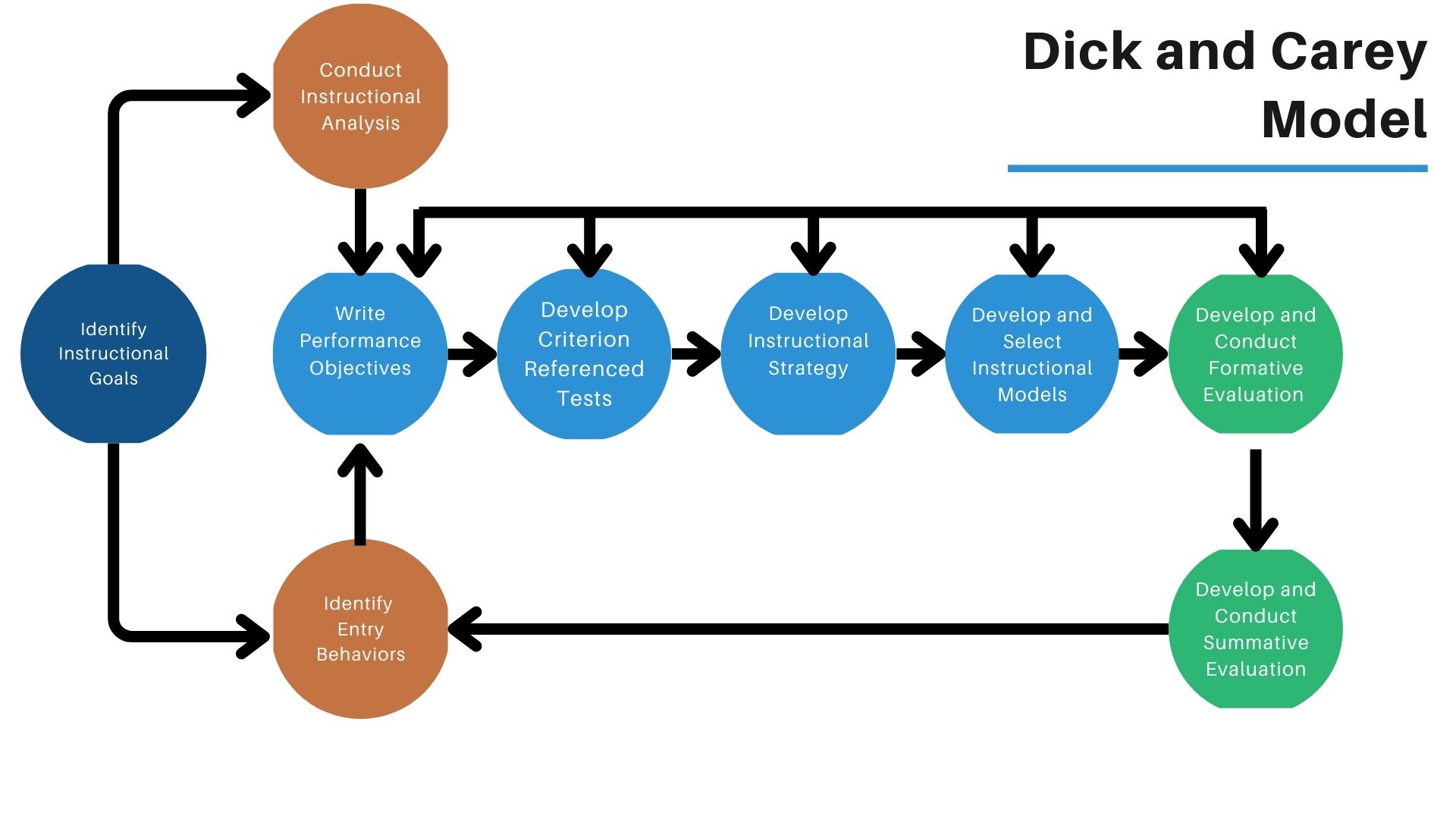The Dick and Carey Model

Illustration of Dick and Carey Model using Canva
The Dick and Carey Model, also known as the Systems Approach Model, is a comprehensive framework for instructional design that focuses on identifying learning goals and designing lessons to achieve them. The model includes 10 interconnected steps:
- Instructional Goals: Define the learning outcomes for students.
- Instructional Analysis: Identify the skills needed to meet these goals.
- Entry Behaviors and Learner Characteristics: Assess students' existing skills and abilities.
- Performance Objectives: Develop measurable objectives to guide instruction.
- Criterion-Referenced Test Items: Create assessments aligned with the objectives.
- Instructional Strategy: Plan activities, teaching methods, and learning materials.
- Instructional Materials: Prepare resources and tools required for the lesson.
- Formative Evaluation: Gather feedback on the lesson's effectiveness.
- Summative Evaluation: Review the overall instructional effectiveness.
- Revision: Continuously refine the teaching process.
Source: Serhat Kurt, "Dick and Carey Instructional Model," Educational Technology, November 23, 2015, updated December 12, 2016.
AP Stats Course and Artifacts
This course was created specifically for AP Statistics students to prepare for the AP Statistics exam. The current version covers Chapter 6: Random Variables. Eventually, the course will include all chapters and full-length practice exams with test preparation resources at the end.
View the AP Statistics Course Page
Artifacts Using the Dick and Carey Model
This course was designed using the Dick and Carey instructional design model. Below are downloadable documents that represent different phases of the design process.
The Dick and Carey Reflection
When I identified my instructional goal, I knew I wanted to focus on AP Statistics. It's a subject I love and am teaching for the first time this year. Originally, I thought about creating a full course covering the entire textbook to prepare students for the AP exam, but that turned out to be too ambitious with the time I had. Instead, I narrowed the scope to focus on Chapter 6: Random Variables, which my in-person class was currently learning.
During the instructional analysis phase, I found myself relearning much of the content. Even though I did well in college statistics, and I’m a math teacher, teaching it for the first time meant I had to break things down in new ways. The more I analyzed the instruction, the more I realized what foundational skills were needed and how the ideas connected.
Analyzing the learners and context helped me ground the project in reality. My students are high school seniors in a low-income community. Many of them are overloaded with AP classes, clubs, and other responsibilities, and they often struggle to stay off their phones. I wanted the course to reflect their world, so I incorporated real-life examples and made the materials more engaging and relevant. I also had to keep in mind that many of them didn’t choose AP Stats for the rigor. It was to be with a teacher who ended up getting transferred. This meant I needed supplemental materials that were simple, clear, and helpful.
For the performance objectives, I leaned on the textbook’s guidance. Even though I wasn’t initially familiar with all the goals, the book's suggested problems helped me figure out what students truly needed to master. This led directly into my assessment planning, and I started designing problems that integrated multiple skills to maximize learning and efficiency.
Instructional strategy was the most time-consuming step, and rightfully so. Breaking down each skill and thinking through how to teach it made me realize how complex it would be to develop a full course this way. Still, it was rewarding. It gave me a deeper understanding of the chapter and how to teach it effectively.
By the time I reached the material development phase, I had a clear plan. I made Instagram-style videos and graphic organizers to match my students' habits and attention spans. That said, it did take a lot of time. Looking back, I could have saved time by leveraging the high-quality videos already available on the AP Stats textbook website.
For formative evaluation, I was fortunate to be teaching the class in person. I could see immediately how students responded. Some worksheets were too difficult without heavy support, which led to more lecture time than I wanted. But the Instagram videos worked well and they boosted engagement and comprehension. Students I hadn’t seen put any effort in, were suddenly watching my videos and understanding the material.
Finally, in the summative evaluation, I got great feedback from the former AP Stats teacher on my campus. He pointed out that I had recreated resources already available on the textbook site and gave me advice on aligning content more closely to the AP exam. That feedback was incredibly valuable and has already changed how I choose materials.
In the end, I’ve taught six chapters of AP Stats this year, and the one I used for this project is by far the one I understand and teach best. This process has helped me grow, and not just as an AP Stats teacher, but as an instructional designer for all my classes.